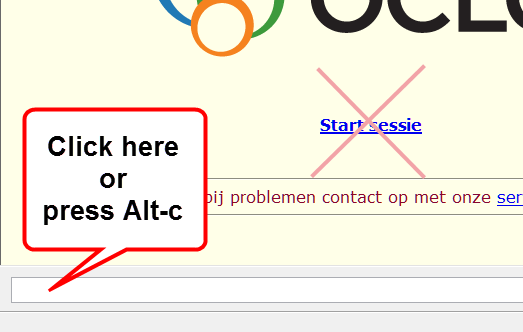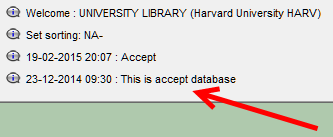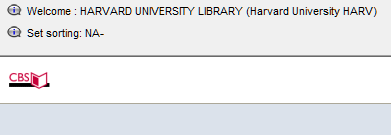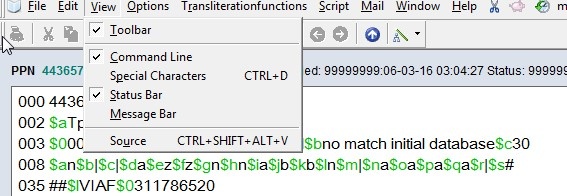Scope: How to log in to the WinIBW client, and tips for using it. Created by: Minna Popkin (Harvard), Amy Armitage (Harvard), John Hostage (Harvard) 
|
Database access
We have access to two databases via the WinIBW client:
- ACCEPT is the test database. Training and experimenting should be done here.
- PRODUCTION is the live ISNI database. Work performed here affects real records.
Logging in to ISNI using the WinIBW client
Getting to the ISNI login page
In the WinIBW client, there are different ways to get to the ISNI login page, depending how you launch the software.
- Windows command line
- You can get directly to the ISNI login page if you launch the WinIBW client from the Windows command line
"C:\Program Files (x86)\OCLC\WinIBW3\WinIBW30.exe" -u:pica3://isni.oclc.org:16035 - You can create a desktop shortcut for this and launch the WinIBW client from that shortcut.
- From the WinIBW shortcut that was added to your desktop when you installed it
- If you launch the WinIBW client from its own shortcut, it will be quicker to get to the ISNI login page if the WinIBW settings on your computer have the ISNI URL:
pica3://isni.oclc.org:16035
in this file:
C:\Program Files (x86)\OCLC\WinIBW3\chrome\ibw\content\start.htm
- From the WinIBW client's command line
- If you have any other URL in the start.htm, you will have to enter the ISNI URL on the client's command line to get to the ISNI login page, as shown below.
- This is useful if you need to switch between Accept and Production.
- The address "pica3://isni.oclc.org:16035” is only accessible through WinIBW.
- Public users without a login cannot use it to access ISNI.
- The port number is non-standard.
|
Logging in to ISNI from the WinIBW command line
Do not click on the link Start sessie (it will lead you to the cataloguing system of the Dutch libraries).
Press Alt-c or mouse-click to get the cursor on the WinIBW command line at the bottom of the screen

ISNI ACCEPT (test)
- Paste the appropriate address into the command line to go to the ISNI ACCEPT system: see ISNI web links (restricted access)
- Press Enter
- Wait for Login screen
- Enter login and password
- It may take a few moments to connect; you may even see "Not Responding" but it will go away once connected
- The window background turns green when connected to the Accept database, and the top left corner shows you are logged into Accept:

ISNI PRODUCTION (live)
- Paste the appropriate address into the command line to go to the ISNI PRODUCTION system: see ISNI web links (restricted access)
- Press Enter
- Wait for Login screen
- Enter login and password
- The window background turns light grey when connected to the Production database; the top left corner shows the following:

You can switch from ISNI ACCEPT to ISNI PRODUCTION and vice versa any time.
- To switch to between the databases, paste the appropriate address into the command line.
If you get an error message saying that the connection was refused, it is possible that your computer's Internet connection is not within the approved IP range. This is likely to happen with a laptop on a wireless connection or when working off campus.
- Solution: restart your laptop on a wired network connection at Harvard, or use the ISNI Web Portal (for more information on that, consult How to use the ISNI web portal).
Passwords
Password assignment
PCC ISNI participants
July 28, 2017: Harvard requested two logins per institution as a first pass, just so that a manageable request would go into OCLC such that we could be assured of quick turnaround on the initial 30 logins. We’ll be back in touch with them shortly to supplement logins for institutions that will have many practitioners involved in the pilot.
Note that ISNI has not required or in our experience so far provided individualized logins. At Harvard, we have assigned individuals to specific logins so that we could troubleshoot any issues with ISNI activity while using the WinIBW client, but otherwise, sharing logins seems not to be a problem, other than potentially conflated searching histories.
At Harvard
All Harvard Quality Team members have individual passwords for working in the WinIBW client. See Amy or Minna for more information.
Changing passwords
The initial passwords given to us by OCLC are the same for each user for PRODUCTION (live) and for ACCEPT (test). However, changing the password in one doesn't automatically change it in the other.
- Launch the web interface.
- Connect to the ISNI ACCEPT system: ISNI web links (restricted access).
- Log in.
- Once logged in, type edit password on the command line, then follow prompts to change the password.
- Write down new password.
- Repeat steps 2-5 on the ISNI PRODUCTION system: ISNI web links (restricted access).
The instructions say that the password must be 0-16 characters long and can only contain characters a-z, A-Z, 0-9.
Each institution's technical contact should implement and manage a change password schedule.
Documentation and How tos
See the sections below, and Pilot 2017-18 documentation and training, particularly these chapters from the British Library:
Creating a new ISNI record in WinIBW
Creating a new record using an existing record
- Call up a record in the client. It must be the same type (person or organization) as you want to create.
- Right click in the record.
- Select Copy to New Window.
- Right click in the record again.
- Select Tile Windows Vertically. There will now be two copies of the same record.
- Click Insert at the bottom of one of the records. This creates a blank window labeled "New record."
- Copy the following fields from the displayed record to the blank window: 002, 003
- Add field 035 with your source code, e.g. 035 $l PCC (the subfield is a lower-case L)
- Add field 700 or 710 with the name by which the person or organization is known. Include subfield $2 with your source code, e.g. 700 1 $a Smith, John Q. $2 PCC
- Add other fields as necessary, including subfield $2 on each one.
- Click Enter. If an index entry with a PPN appears, double click on it to see the new record.
Creating a new record from scratch
- If no record is displayed on the screen, enter the Insert command on the command line. It can be abbreviated 'ins'
- If a record is displayed, click on the Insert command box at the bottom of the screen.
- A blank window labeled "New record" will be displayed.
- Copy one of the following templates into the window.
Persons
002 $aTpx
008 $an$b|$c|$da$e|$fz$gn$hn$ia$j|$kb$ln$m|$nn$oa$pa$qa$r|$s|
035 $lPCC
700 1 $a[Last name, First name]$2PCC
910 $a[Title]$2PCC
671 $gr$u[URL]$2PCC
Organizations
002 $aTbx
008 $an$b|$c|$da$e|$fz$gn$hn$ia$j|$kb$ln$m|$nn$oa$pa$qa$r|$s|
035 $lPCC
710 2 $a[Corporate body name]$2PCC
910 $a[Title]$2PCC
671 $gr$u[URL]$2PCC
Notes
- The minimum required fields are 002, 008, 035, and either 700 or 710.
- ISNI does not read the values in field 008, so it doesn't matter if the field is copied from another record that doesn't exactly match this template.
- ISNI ignores indicators in 4XX and 7XX fields, so it doesn't matter if they are included.
- Adjust the source codes to the code that matches your login, if necessary.
- ISNI inserts the symbol '@' before the first word to be filed on in field 910, i.e. it skips over initial articles. This symbol should not be inserted manually.
- The subfield delimiter is '$' as found on the keyboard.
- Code "r" in 671 $g indicates that the information has been reviewed. This is the default for PCC contributions. The field is not required.
Merging records
Merging records when one already has 77A
- Retrieve the record with the 77A field. If it has '$b P', that indicates a possible merge.
- Enter '\dup' on the command line. The record will be displayed in edit mode beside the record with a PPN indicated by 77A $9.
- If the records should be merged, click the Equal button. Otherwise, click Unequal or Unknown, as appropriate.
Merging records when none has 77A
- Retrieve the record that has a duplicate.
- Right click in the record.
- Select Copy to New Window.
- Retrieve the other record that is a duplicate. This can be done by clicking the blue back arrow on the toolbar (or Ctrl+B) to return to the search history or by doing a new search.
- When the other record is found, right click in the record.
- Select Tile Windows Vertically.
- Click the Update button under one of the records to enter edit mode. It doesn't matter which one.
- Add field 77A to the record
- Person: 77A $aISNI#PERSON$bM$9[PPN of other record]
- Organization: 77A $aISNI#ORG$bM$9[PPN of other record]
- Copy the PPN from field 000 of the other record.
- Click Enter to save the record.
Notes
- It doesn't matter which record gets the 77A field. The system will merge the records according to criteria outlined in the WinIBW manual. The cataloger cannot determine which record is retained.
- For more details, see section 4.1 of the WinIBW manual.
- Don't change the status of any of the records before merging.
- Merges are processed twice a day by the system.
- It is possible to have more than one 77A in a record to merge multiple records.
- When a merge is initiated in the client, the system adds field 006 with the logon ID of the individual in subfield $b
- Add linking fields, such as related person or organization, only after the merge has completed. Otherwise, the links (which rely on the PPN) may be broken.
- Find the record to be upgraded.
- Click on the Update button.
- In field 003, delete '$aprovisional$bno match initial database'
- Insert '$aassigned'
- Leave subfield $c in the record.
- Click on the Enter button.
Specific scenarios/questions from PCC participants
Diacritics
Copy and paste can be used. However, on WinIBW diacritics can also be accessed using the following methods:
1. CTRL+D – Selecting CTRL+D on WinIBW brings up a list of diacritics at the top of the screen:

Just put the cursor in the appropriate place on the record and select the relevant diacritic to be inserted. The Unicode character/name can also be viewed by hovering over each diacritic. Note that for diacritics to be inserted into a record you will need to select UPDATE and be in the editing screen.
To remove the list of diacritics from the top of the screen just select CTRL+D again.
2. VIEW > SPECIAL CHARACTERS – Alternatively, select VIEW and SPECIAL CHARACTERS to display the list of diacritics:

Selecting SPECIAL CHARACTERS will display the list of diacritics at the top of the screen. Follow the same procedure as above to insert diacritics into the record. To remove the list of diacritics, go to VIEW and de-select SPECIAL CHARACTERS from the list.
Version
As of April, 2017, we use version 3.7.1. We were specifically instructed by OCLC to install the Dutch version.
Settings
You can type eng into command line to switch language, but it may not be necessary because the interface language seems to change once you log in.
Toolbar
If the toolbar is not displaying and you have a Dutch menu bar across the top, follow these steps to open the toolbar:
- Click on "Beeld" (view)
- Click on "Werkbalk" (toolbar)

This displays a set of icons that can be useful for working in a list. The tool tips are in English.

This setting does not seem to be persistent from one session to the next.
Documentation re WinIBW training sessions Feb. 6, Feb. 7, 2018
This information was provided by the ISNIQT.
Agenda for sessions
Sessions.docx
Training documentation
- Manual parts relevant to the sessions.docx
- PCC training: 1st session queries:this is a short summary of searching on WinIBW along with further information about the 77A field, put together by Michael Docherty of the BL/ISNIQT.
- Browse and Scan produce the same search results so you would only need to use one search. Find can be used for names and we have provided some examples in the attached document.
- The direct/indirect order of names does not matter with a bro/sca search so we have added some examples in the document.
- We are currently revising the documentation which should be ready to send through in March, 2018. We did send an appendix containing all the ISNI data elements in advance of yesterday’s session so let us know if you did not receive this. However, it does not state which subfields are mandatory so we will add this and send a copy to everyone after the training.
WinIBW training tutorials
See the videos on the ISNI tutorial videos page.



